How to rank stocks based on a company achievement and the stock value

In this post, you will learn the method of how to rank stocks based on company achievements and the value of the stock. So, through this post, I will show you how to properly “pick a stock” from a collection of stocks, which is a crucial skill for any equity research analyst.
This post’s content is not intended to be investment advice and does not constitute an offer to perform any operations in the regulated or unregulated financial market.
By the end of this post, you will be able to analyze stocks to make better investment decisions.
The main goal of the post is to know:
- How to rank stocks based on company performance
- How to evaluate stocks based on their value
But first… some theory.
Stocks Rank Strategies in Investment
Before I go into detail on how I rank stocks, I’d like to discuss some common stock trading strategies. So, in the few following paragraphs, I will go through a couple of stock investment strategies.
Technical Trading Strategy
To start with, technical trading happens when investors examine stock charts to see whether they can spot short-term trading opportunities. Let’s look at a very simple technical research approach to give you an understanding of how a technical analyst takes decisions.
Many analysts believe that the best time to invest in a stock is when the on-balance volume indicator (OBV) and a stock price are rising. So, in that case, the OBV indicator acts as a trend confirmation tool.
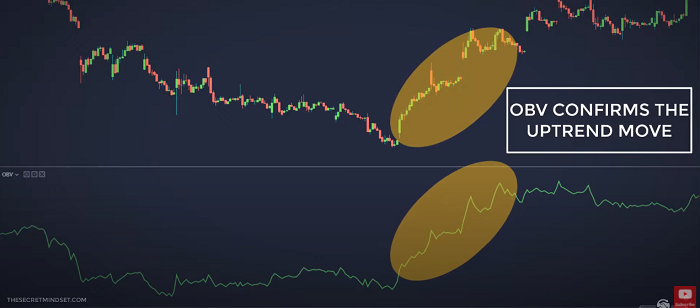
On Balance Volume (OBV) measures buying and selling pressure as a cumulative indicator, adding volume on up days and subtracting it on down days. OBV was developed by Joe Granville and introduced in his 1963 book Granville’s New Key to Stock Market Profits. Source
Most charting software will have an add-on for the on-balance volume indicator. However, that is just one indicator. There are literally hundreds of indicators that technical analysts use. But one of the first measures of positive and negative volume flow was OBV.
So, in this paragraph, we have little covered one of the popular investing strategies named technical trading. Now I would like to move on to the next investment strategy.
Fundamental and Value Investing
Value investing is the practice of buying stocks at a discount of their true worth. Value investors actively seek stocks of companies they believe the market has undervalued. This involves reading financial statements and using fundamental analysis.
Fundamental analysis is a technique that attempts to determine a security’s value by focusing on underlying factors. That factors affect a company’s actual business and its future growth forecasts. So that, analysts tend to focus on analyzing a company’s financial statements such as Balance Sheet, Income Statement, and Statement of Cash Flows.
Financial Statements
First is the balance sheet, which represents a record of a company’s assets, liabilities, and equity at a particular point in time. In particular, a company’s assets are the resources that the business holds at a given point in time. Assets may include items such as cash, inventory, machinery, buildings, and personal.
Next is an income statement which measures a company’s performance across a specific period in time. The income statement presents information about revenues, expenses, and profit that business operations have generated for that period.
And the third statement is the Statement of Cash Flows, which represents a record of business cash inflows and outflows across the period in time. It includes Operating Cash Flow, the business operations day-to-day generated cash. Such as cash from investing, as well as the proceeds from the sale of other businesses, equipment, or long-term assets. Statement of Cash Flows also includes cash from financing, which measures the flow of cash between a company and its owners and creditors.
Financial Ratios
Investors will typically look at financial ratios to help them make better decisions. The rations are creating by calculating the relationship between items on the financial statement with each other and/or outside organizations. Here are the financial ratios we will be using in our stocks rank calculations (the less the value the better):
- P/B (Price to Book) – estimates the market’s valuation of a company relative to its book value. The lower the value the better.
- P/E (Price to Earnings) – relates a company’s share price to its earnings per share. A high ratio could mean that a company’s stock is over-valued, or else high expectations of investors.
- P/S (Price to Sales) – the lower the ratio, the more charming the stock. Provides a useful measure for sizing up stocks.
- P/CF (Price to Cash Flow) – multiple that compares a company’s market value to its operating cash flow. It may indicate that a stock is undervalued in the market.
So, as we have covered some theory, let us begin with the rank of the stocks themselves. To be precise, we are going to rank two companies: Microsoft (MSFT) and Amazon (AMZN). So, let us get started.
Practice to Rank Stocks
To begin with, for the statistics gathering we will be using the well-known resource Yahoo Finance. It allows us to find stock data by simply typing the company stock ticker. In our case, the tickers are MSFT and AMZN.
Thus, let’s start by getting information related to Microsoft stock. First, go to Yahoo Finance and type MSFT into the search bar (or just click here https://finance.yahoo.com/quote/MSFT?p=MSFT&.tsrc=fin-srch). Next click on the ‘Financials’ tab.

We need to gather the company’s income statement information such as Total Revenue, Gross Profit, EBIT, Net Profit.
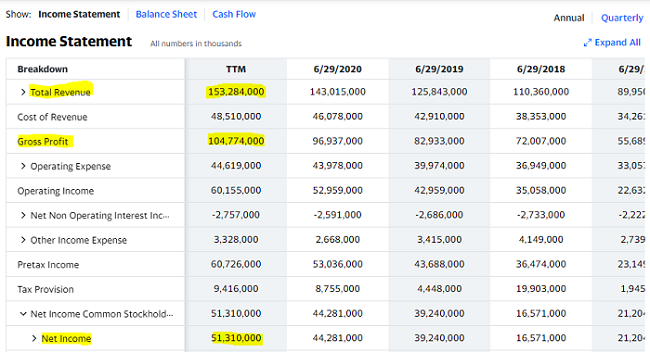
We will need this information later for profit margin calculations. Now, get the income statement information and put it into the table (I prefer Excel document). As a result, you will get something like that.

Following we need to go to the ‘Balance Sheet’ tab and find Total Assets, Total Liabilities, Total Equity, Current Assets, and Current Liabilities. We will need this information later to calculate company performance margins.

Next step is to put this information into the table.
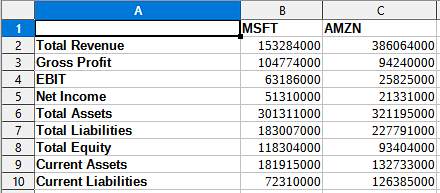
Now we need to find the company’s Capitalization and the company’s Free Cash Flow data so that we can calculate the value stock ratios. First, we need to go back to Yahoo Finance and find Operating Cash Flow statistics on the ‘Cash Flow’ tab. Next, click on the ‘Summary’ tab and copy-paste Market Cap information accordingly.
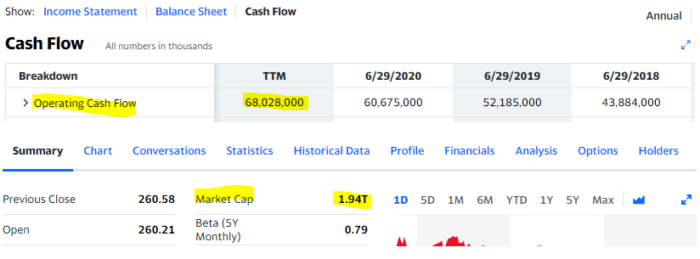
Now, as we have all the needed information we can start calculating company performance margins and the value of the stock.
Calculating Company Performance Margins
Thus, let’s start by calculating the companies performance margins. We will be using data we gathered previously such as Total Revenue, Gross Profit, EBIT, Net Income, Total Assets, Total Liabilities, Total Equity, Current Assets, Current Liabilities, Capitalization, and Operation Cash Flow.
We are going to calculate these performance margins:
- Gross Profit Margin – The balance of money left over from goods sales after subtracting the cost of goods sold (COGS).
Gross Profit Margin = Gross Profit / Total Revenue. - EBIT Margin – It allows investors to understand the true business costs of operating a business. EBIT Margin = EBIT / Total Revenue
- Net Profit Margin – It allows investors to calculate the percentage of profit a business produces from its total revenue.
Net Profit Margin = Net Income / Total Revenue - ROE (Return on Equity) – It shows the company’s strength to turn equity investments into profits.
ROE (Return on Equity) = Net Income / Total Equity - ROA (Return on Assets) – It indicates how good a business is doing by analyzing the profit it’s generating to the money it’s funded in assets.
ROA (Return on Assets) = Net Income / Total Assets - Total Revenue Growth – The total amount of cash a business makes from providing its services to clients before paying expenses.
Total Revenue Growth = (Current Period Revenue – Previous Period revenue) / Previous period revenue. However, I took this information from the internet. Four each for each company https://www.macrotrends.net/stocks/charts/MSFT/microsoft/revenue / https://www.macrotrends.net/stocks/charts/AMZN/amazon/revenue - EBIT Growth – Earnings Before Interest and Tax growth. To be honest, I also took this information from the internet.
Four years for each company https://www.macrotrends.net/stocks/charts/MSFT/microsoft/ebit / https://www.macrotrends.net/stocks/charts/AMZN/amazon/ebit - D/E (Leverage) – It demonstrates the stockholder equity’s ability to meet all remaining commitments in the case of a business decline.
D/E (Leverage) = Total Liabilities / Total Equity - Current Ratio – It assesses a company’s willingness to fulfill its short-term commitments, which are due within a year.
Current Ratio = Current Assets / Current Liabilities
Calculating Value of the Stock
Next, we need to calculate the value stock ratio (stock price ratios)
- P/B (Price to Book) = Capitalization / Total Assets
- P/E (Price to Earnings) = Capitalization / Net Income
- P/S (Price to Sales) = Capitalization / Total Revenue
- P/CF (Price to Cash Flow) = Capitalization / Operating Cash Flow
All these ratios were covered previously in this post. You can easily find this information by clicking on this anchor.
Rank Stocks Final Results and Conclusion
Now, as we know how to calculate business performance metrics as well as a value stock ratio. Let us calculate and estimate these values and put everything into the table. The final result should be as in the image below.
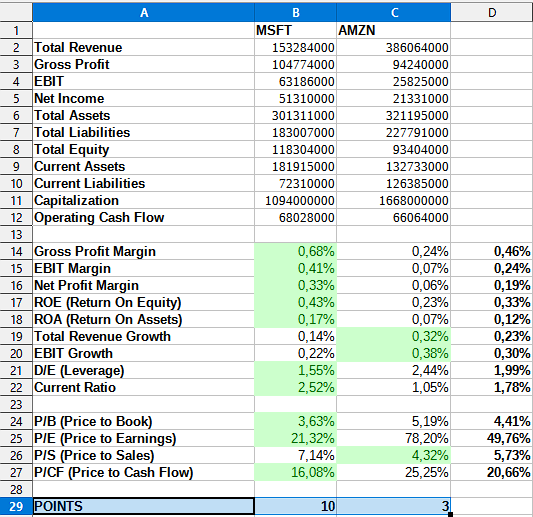
If you wish, you can even download the whole file from Google drive (Rank Stocks final results). The file is in ‘ods’ format (Libre Office its free).
Let me explain my final results. As you can see I evaluated each metric and ratio value by calculating an average for each of them. So that I can understand which metrics/rations perform better. I assigned one point to the company if the appropriate metric was higher than the average (exception is D/E ratio). Regarding the value stock ratio, the situation is the opposite. I assigned one point to the company if the appropriate value of the stock ratio is less than the average. As a result, the Microsoft stock is the winning one.
Thanks for reading the post to the end! If you liked it, please share it. If you would like to know how to get started with investing, please read Investing Getting Started.
This post’s content is not intended to be investment advice and does not constitute an offer to perform any operations in the regulated or unregulated financial market.









Hello! Just finished reading your article on A/B testing with ClickFunnels—what an insightful read! Your breakdown of the A/B testing…